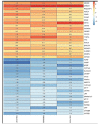Bioinformatics Analysis based on Multiple Databases Identifies Hub Genes Associated with Hepatocellular Carcinoma
- PMID: 32476992
- PMCID: PMC7235396
- DOI: 10.2174/1389202920666191011092410
Bioinformatics Analysis based on Multiple Databases Identifies Hub Genes Associated with Hepatocellular Carcinoma
Abstract
Background: Hepatocellular carcinoma (HCC) is the most common liver cancer and the mechanisms of hepatocarcinogenesis remain elusive.
Objective: This study aims to mine hub genes associated with HCC using multiple databases.
Methods: Data sets GSE45267, GSE60502, GSE74656 were downloaded from GEO database. Differentially expressed genes (DEGs) between HCC and control in each set were identified by limma software. The GO term and KEGG pathway enrichment of the DEGs aggregated in the datasets (aggregated DEGs) were analyzed using DAVID and KOBAS 3.0 databases. Protein-protein interaction (PPI) network of the aggregated DEGs was constructed using STRING database. GSEA software was used to verify the biological process. Association between hub genes and HCC prognosis was analyzed using patients' information from TCGA database by survminer R package.
Results: From GSE45267, GSE60502 and GSE74656, 7583, 2349, and 553 DEGs were identified respectively. A total of 221 aggregated DEGs, which were mainly enriched in 109 GO terms and 29 KEGG pathways, were identified. Cell cycle phase, mitotic cell cycle, cell division, nuclear division and mitosis were the most significant GO terms. Metabolic pathways, cell cycle, chemical carcinogenesis, retinol metabolism and fatty acid degradation were the main KEGG pathways. Nine hub genes (TOP2A, NDC80, CDK1, CCNB1, KIF11, BUB1, CCNB2, CCNA2 and TTK) were selected by PPI network and all of them were associated with prognosis of HCC patients.
Conclusion: TOP2A, NDC80, CDK1, CCNB1, KIF11, BUB1, CCNB2, CCNA2 and TTK were hub genes in HCC, which may be potential biomarkers of HCC and targets of HCC therapy.
Keywords: Hepatocellular carcinoma; bioinformatics; database; differentially expressed gene; hub gene; mRNA.
© 2019 Bentham Science Publishers.
Figures






Similar articles
-
Integrated Bioinformatics Analysis for the Screening of Hub Genes and Therapeutic Drugs in Hepatocellular Carcinoma.Curr Pharm Biotechnol. 2023;24(8):1035-1058. doi: 10.2174/1389201023666220628113452. Curr Pharm Biotechnol. 2023. PMID: 35762549
-
Bioinformatics Analysis of Candidate Genes and Pathways Related to Hepatocellular Carcinoma in China: A Study Based on Public Databases.Pathol Oncol Res. 2021 Mar 26;27:588532. doi: 10.3389/pore.2021.588532. eCollection 2021. Pathol Oncol Res. 2021. PMID: 34257537 Free PMC article.
-
[Bioinformatics analysis of core differentially expressed genes in hepatitis B virus-related hepatocellular carcinoma].Zhongguo Xue Xi Chong Bing Fang Zhi Za Zhi. 2022 Nov 21;34(5):507-513. doi: 10.16250/j.32.1374.2021292. Zhongguo Xue Xi Chong Bing Fang Zhi Za Zhi. 2022. PMID: 36464255 Chinese.
-
Identification and Analysis of Potential Key Genes Associated With Hepatocellular Carcinoma Based on Integrated Bioinformatics Methods.Front Genet. 2021 Mar 9;12:571231. doi: 10.3389/fgene.2021.571231. eCollection 2021. Front Genet. 2021. PMID: 33767726 Free PMC article.
-
Integrative Bioinformatics Analysis for Targeting Hub Genes in Hepatocellular Carcinoma Treatment.Curr Genomics. 2025;26(1):48-80. doi: 10.2174/0113892029308243240709073945. Epub 2024 Jul 18. Curr Genomics. 2025. PMID: 39911278 Free PMC article.
Cited by
-
Silencing GDI2 inhibits proliferation, migration and invasion of colorectal cancer through activation of p53 signaling pathway.Heliyon. 2024 Sep 13;10(18):e37770. doi: 10.1016/j.heliyon.2024.e37770. eCollection 2024 Sep 30. Heliyon. 2024. PMID: 39323841 Free PMC article.
-
The Landscape of the Tumor Microenvironment in Skin Cutaneous Melanoma Reveals a Prognostic and Immunotherapeutically Relevant Gene Signature.Front Cell Dev Biol. 2021 Oct 1;9:739594. doi: 10.3389/fcell.2021.739594. eCollection 2021. Front Cell Dev Biol. 2021. PMID: 34660598 Free PMC article.
-
Upregulation of multiple key molecules is correlated with poor prognosis and immune infiltrates in hepatocellular carcinoma by bulk and single-cell RNA-seq.Aging (Albany NY). 2024 Nov 12;16(21):13371-13391. doi: 10.18632/aging.206151. Epub 2024 Nov 12. Aging (Albany NY). 2024. PMID: 39537209 Free PMC article.
-
Construction of a Promising Tumor-Infiltrating CD8+ T Cells Gene Signature to Improve Prediction of the Prognosis and Immune Response of Uveal Melanoma.Front Cell Dev Biol. 2021 May 28;9:673838. doi: 10.3389/fcell.2021.673838. eCollection 2021. Front Cell Dev Biol. 2021. PMID: 34124058 Free PMC article.
-
Tumor stemness and immune infiltration synergistically predict response of radiotherapy or immunotherapy and relapse in lung adenocarcinoma.Cancer Med. 2021 Dec;10(24):8944-8960. doi: 10.1002/cam4.4377. Epub 2021 Nov 5. Cancer Med. 2021. PMID: 34741449 Free PMC article.
References
-
- Kunnathuparambil S.G., Anoobjohn K., Zameer P.K.M., Sreesh S., Narayan P., Vinayakumar K.R. Is alcohol abstinence a risk factor for development of hepatocellular carcinoma (HCC) in alcohol related cirrhosis? J. Clin. Exp. Hepatol. 2013;3(1):S104–S104. doi: 10.1016/j.jceh.2013.03.176. - DOI
-
- Kühn T., Nonnenmacher T., Sookthai D., Schübel R., Quintana Pacheco D.A., von Stackelberg O., Graf M.E., Johnson T., Schlett C.L., Kirsten R., Ulrich C.M., Kaaks R., Kauczor H.U., Nattenmüller J. Anthropometric and blood parameters for the prediction of NAFLD among overweight and obese adults. BMC Gastroenterol. 2018;18(1):113. doi: 10.1186/s12876-018-0840-9. - DOI - PMC - PubMed
LinkOut - more resources
Full Text Sources
Miscellaneous
